Samsung Galaxy Tab S4 Review
Samsung Galaxy Tab S4 Review
Making Android tablets interesting again?
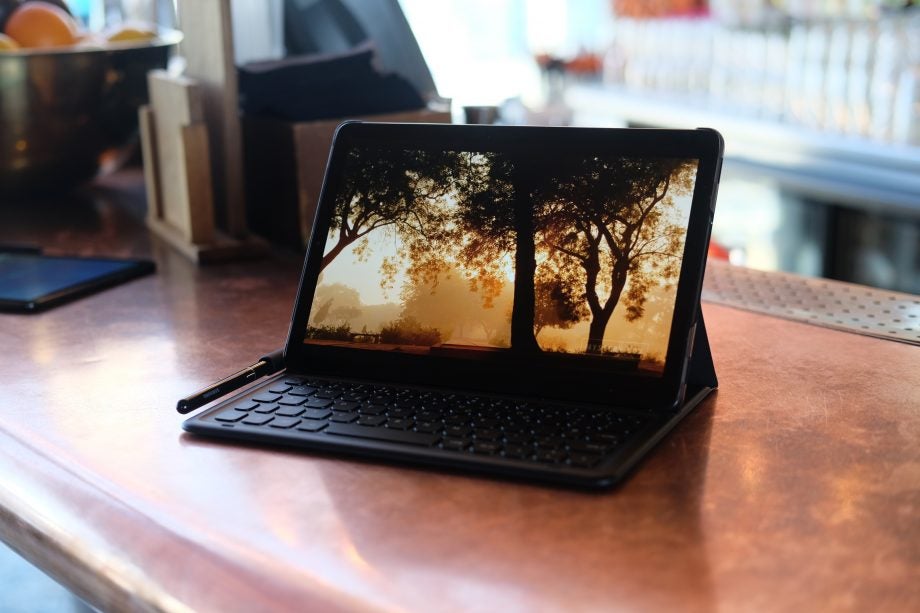
Verdict
The Samsung Galaxy Tab S4 is the best Android tablet you can buy. It's pricey, but for the money you get a stunning screen, and as someone who watches a lot of videos on a tablet, I'd happily spend extra for a panel this colourful and sharp. I'm not sure this is a great buy for those wanting a tablet just for web-browsing, a bit of gaming and the odd Netflix watch on a train, however. But if you want a high-end Android tablet then the Tab S4 is the device to get.
Pros
- Stunning display
- Dex mode is an improvement to the UI
- S-Pen included
Cons
- Would like more RAM
- Glass back is slippery and delicate
- Lingering issues with Android on tablets
- Dex mode has a few annoying bugs
Key Specifications
- Review Price: £599
- 10.5-inch HDR Super AMOLED display
- Optional keyboard cover
- Snapdragon 835, 4GB RAM, 64GB storage
- Expandable via microSD
- 7300 mAh battery, USB-C, Fast Charge
- S-Pen included
- Dolby Atmos
- Dex
What is the Samsung Galaxy Tab S4?
If you’re on the hunt for an Android tablet with specs to match Apple’s iPad Pro 10.5 then options will have been thin on the ground recently. Huawei’s MediaPad M5 8.4 and Huawei MediaPad M5 Pro offer decent specs and features, while Amazon’s Fire HD range have the mid-range covered. But high-end Android tablets are rare.
That’s where Samsung and its Tab S4 come in. This device is as high-end as you can get: a fast processor, a gorgeous HDR OLED and the S-Pen included. It even manages to swerve the normally quite poor Android interface with some smart software choices.
Samsung Galaxy Tab S4 – Design
There’s a whole lot to like about the Tab S4. However, its design and build aren’t on that list. It’s a design that works exceptionally well for phones, but not so much for tablets.
My biggest concern is the glass rear. Not only do I fear that it will become damaged every time I put the device into my bag uncovered, but it’s super-slippery, even after only a few minutes of holding it. Any oily residue on your hands will instantly transfer onto the glass, leaving the device a smudge-covered mess. The cool feel of metal is far more reassuring on a tablet.
At least the device is thin and light. Slipping it in a bag will result in no noticeable weight gain, and I could hold it in one hand whilst scribbling some notes without feeling any strain.
The rest of the rear is clean, with a camera and flash, Samsung branding and a ‘Tuned by AKG’ logo. My review unit was a glossy black, and there’s a whitey/grey version available too.
Around the metal sides you’ll find a volume rocker, standby switch and a set of POGO pins for connecting up the Book Keyboard Cover, which is sold separately. A USB-C port sits along the bottom edge, flanked by a 3.5mm headphone port.
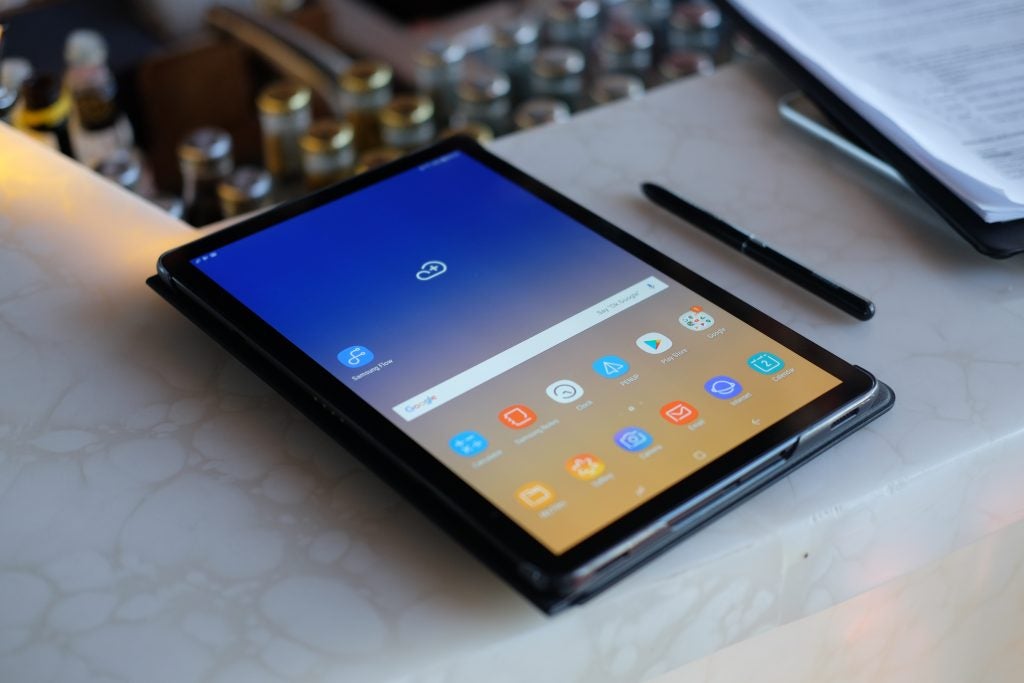
Easily the biggest omission is the home button, which has been a mainstay of the Tab line. It’s been ditched here in favour of a larger screen with a thinner bezel, and it’s a good move. There’s very little need for a dedicated home key here and in my experience, I haven’t found fingerprint sensors on tablets all that useful.
Those after extra protection will be pleased to learn that the Tab S4 features the same iris scanner as the Samsung Galaxy S9. It works fine, although in landscape orientation it sometimes struggles to accurately find your face.
The stretched-out 10.5-inch display covers the majority of the front of the Galaxy Tab S4. This larger display has resulted in a reduction in the bezel surrounding it compared to the outgoing Tab S3, although it isn’t quite as eye-catching as the Infinity Display on the Samsung Galaxy S9. There’s no curve to the panel – which is probably a good thing for a tablet of this size.
Also available with the Tab S4 is a keyboard folio case. It will come free with pre-orders in the UK, and cost £119/$149 thereafter. I’ve only played with the Book Keyboard briefly, so I’ll save my complete thoughts for an update to this review once I’ve spent more time with it.
Samsung Galaxy Tab S4 – Screen and S-Pen
The screen on the Samsung Galaxy Tab S4 is utterly gorgeous, and right up there with the iPad Pro 10.5 for having the finest display on any tablet you can buy right now.
Samsung’s big win over Apple is the use of OLED tech, opposed to IPS LCD. OLED is used in some of the best TVs we’ve reviewed this year, and it allows for perfect blacks and striking colours. The panel is HDR-enabled for apps such as Netflix and Prime Video, and it packs a high resolution of 2560 x 1600. Really, it ticks all the boxes.
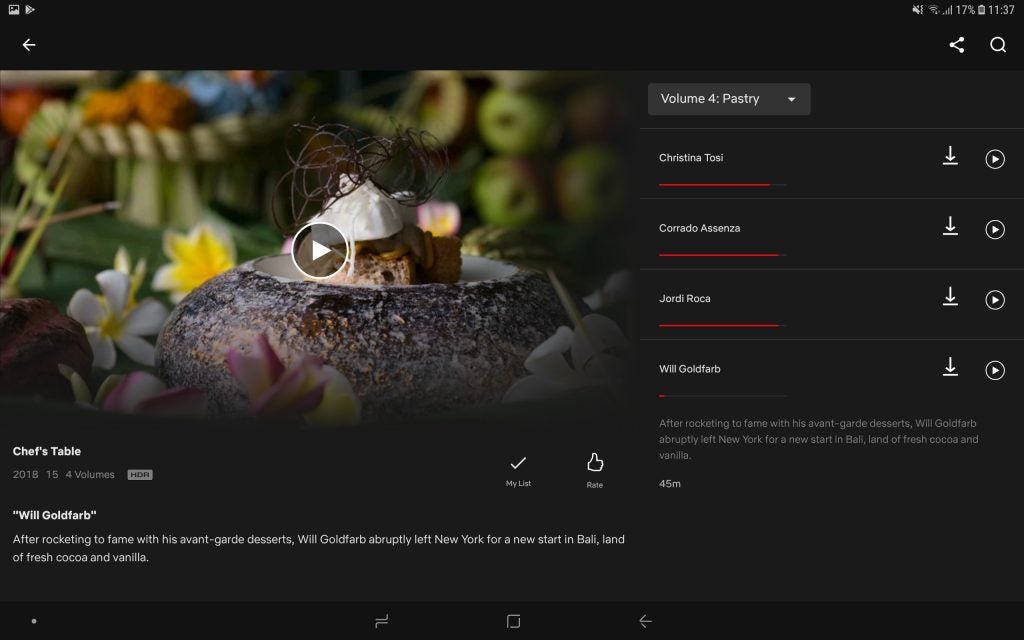
Netflix supports HDR
For watching movies on-the-go there’s simply nothing better. Colours are punchy and bright, viewing angles are wide enough for a couple of people to watch simultaneously, and there’s a good hit of brightness. I did find myself jacking up the brightness to 100% when in sunnier surroundings or on the train in the morning, but turning things down to about 60% will suffice indoors.
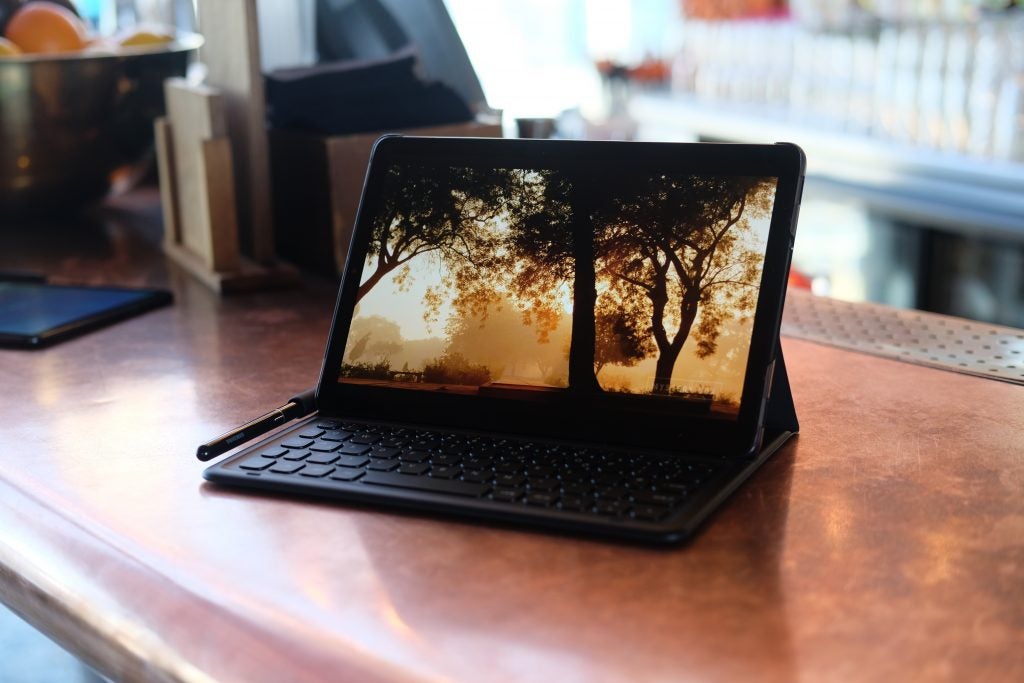
I’ve been switching between the Tab S4 and Apple’s iPad Pro 10.5 over the past few days to try to decide which is better, and it’s a tight call.
The Tab S4 is easily better for binge-watching on Netflix, not only because of the punchier panel, but because the 16:10 aspect ratio is better suited to widescreen video.
The iPad Pro, on the other hand, has a 120Hz refresh rate, which makes swiping and scrolling a lot smoother. I’d also say the iPad displays colours slightly more accurately – to my eye anyway – and editing the same photos on both devices in Adobe Lightroom CC was a better experience on the iPad as a result.
Really, it comes down to what you value more in a display.
Related: Best tablet 2019
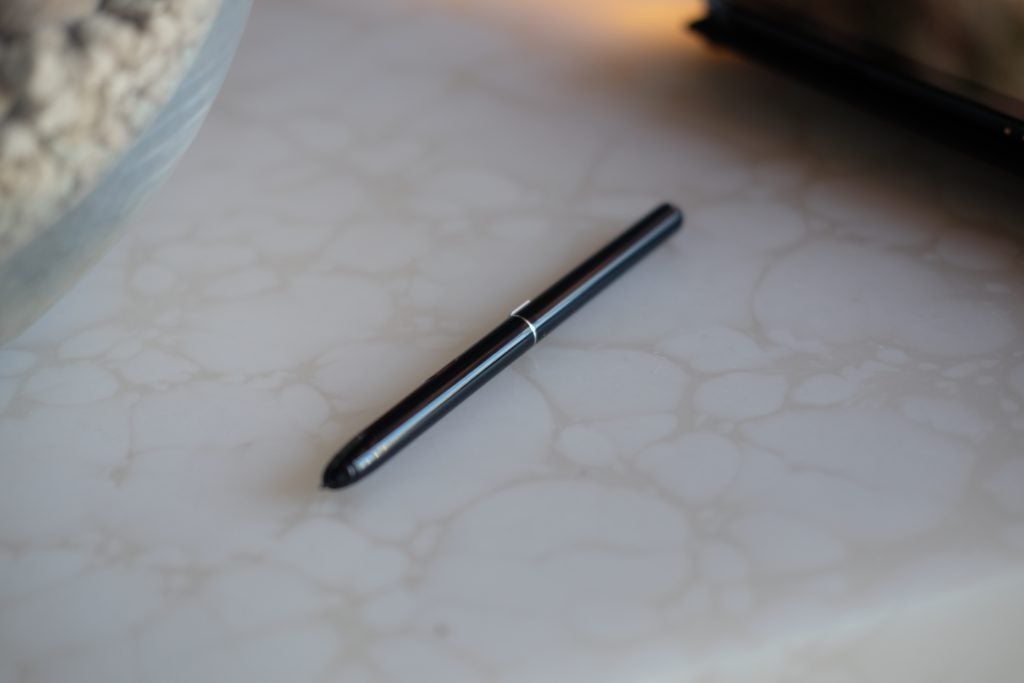
Included with the Tab S4 is an S-Pen: a Wacom-powered stylus for doodling and note-taking. Unlike the S-Pen that slides into the Samsung Galaxy Note 8, the version here is chunkier and made completely from plastic – it feels a lot like a felt-tip pen.
Considering how thin this tablet is, there’s nowhere for the S-Pen to live. It would have been nice to see Samsung follow Microsoft’s lead and add in some magnets for sticking the S-Pen to the side. I love this feature on the Surface Pro, and it stops the pen getting lost in your bag.
Not being a particularly great artist myself, I gave the device and stylus to a team member who used to work as an artist to give it a whirl. They found that as a creative tool the Tab S4 is a significant step up on competing Android tablets, such as the 10-inch Huawei MateBook. The S Pen is one of the best tablet styluses around, offering a solid 4096 pressure sensitivity levels and pleasing 0.7 mm rubber tip. The tip gives the pen a degree of resistance when writing on the screen – something that is missing on competing styluses, including the Apple Pencil.
Scribbling in Samsung Notes, the pen was reactive and didn’t suffer any latency. Samsung hasn’t pre-installed any third-party apps for doodling, photo editing or vector work. Testing the pen in Autodesk Sketchbook, Adobe Sketch and Adobe Draw, the pen performed well. Pressure sensitivity levels were accurately read and good enough to comfortably sketch and ink pencils.
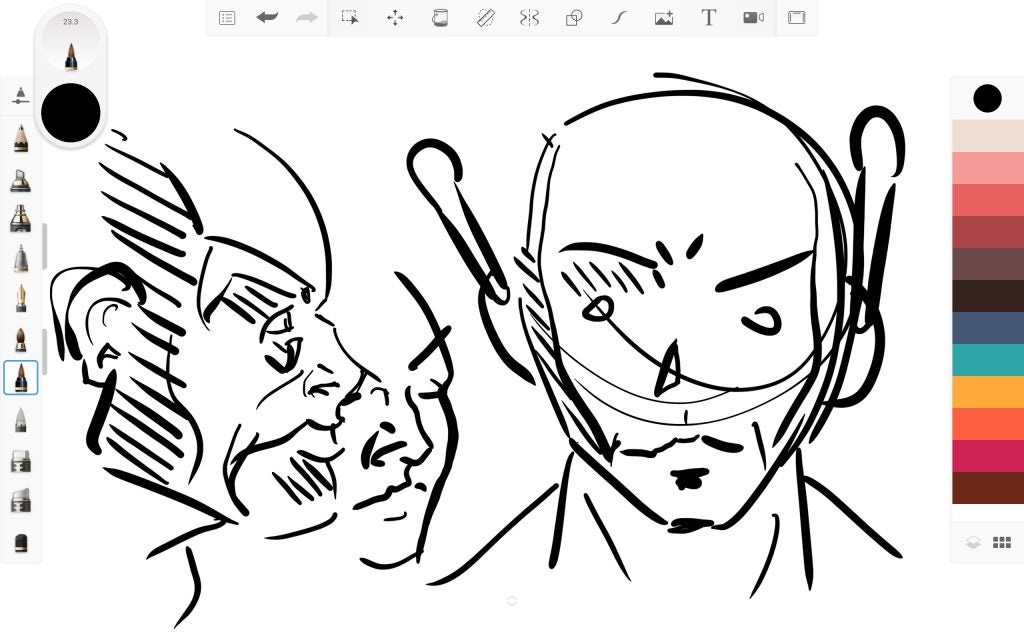
Multiple apps support S-Pen input
The only minor annoyance was that S Pen’s quick menu can easily be launched accidentally using the side shortcut button. It would better if you could customise the button’s function on an app-by-app basis. All in all, the combo works well enough to make up for the lack of customisability, however.
If you’re a creative after a mobile touch-up station or sketchpad that isn’t an iPad or Surface, then the Galaxy Tab S4 is a solid choice.
Samsung Galaxy Tab S4 – Performance, audio and camera
There are four speakers on the Galaxy Tab S4: two along the bottom and two on the top. Each has been ‘tuned’ by AKG – a brand owned by Samsung – and they’re capable of pushing out Dolby Atmos audio.
Enabling the Atmos setting does result in a fairly decent faux-surround feel. However, it sounds a little fake and processed at loud volumes, tending to feel a bit tinny. At least a headphone jack is included.
Related: What is Dolby Atmos?
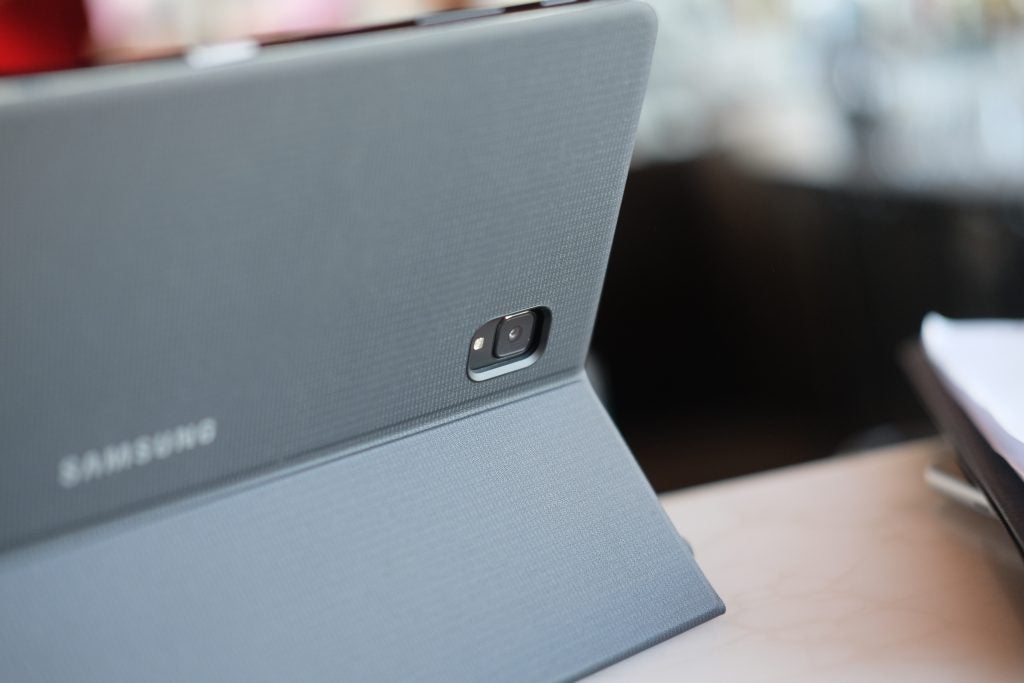
Inside the Galaxy Tab S4 there’s a Snapdragon 835, 4GB of RAM and, in the UK, 64GB of storage (some regions will get a 256GB option too). A microSD slot is included, so you can expand that further.
In 2017, this would have been a flagship setup. In 2018 it feels slightly limited, though. Especially for the £599 price. 4GB of RAM is tight, and leaves multi-tasking in Dex mode feeling unreliable. I’m less disappointed about the inclusion of the Snapdragon 835, however. Apps run fine, and even games such as Asphalt 9 are fast and smooth.
See below for a look at how the Tab S4 performs in Geekbench 4 tests, when compared to the Tab S4 and the two current iPads.
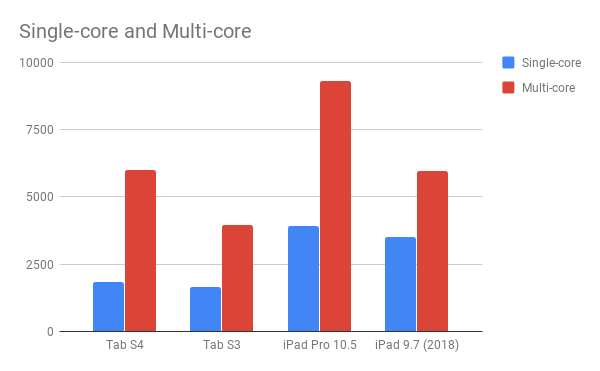
Cameras are far from the most important part of a tablet, and Samsung hasn’t done much here to show it has focused any time or effort on them. There’s a single 13-megapixel f/1.9 camera on the back, and an 8-megapixel version on the front.
Pictures remind me of those taken with a mid-to-low-end phone, maybe the Galaxy A6 (2018). They’re colourful, with decent detail; they get the job done if the environment is bright. Low-light performance is poor and you’ll likely get better results from your phone. The front 8-megapixel sensor is good for video calls – I was using Google’s Duo app for this – with nice facial details and sufficient brightness.
My review unit came with LTE/4G support, which worked perfectly once I’d added a Three SIM-card inside. It works for phone calls and messages, too. For LTE connectivity you’ll have to pay an extra £50 (£649 as opposed to £599). That seems a fair price and I’d likely choose that option just for the extra freedom you get with 4G.
Samsung Galaxy Tab S4 – Software
Android tablets have always felt hamstrung because of the software. Android is great on phones, but poor on anything larger. The lack of updates and support from Google has meant that it’s been up to third-party developers to try to get the job done. Considering there don’t appear to be any tablet-specific features in Android Pie, things look set to continue in this vein.
In an attempt to get around this, Samsung has plucked its Dex interface from the Galaxy S9. Dex is a completely separate UI, which was previously only available when you connected a compatible Samsung phone into a Dex dock and a monitor. It would then let you attach a mouse and keyboard and use the phone like a more traditional desktop PC.
The Dex UI’s strength lies in its windowed interface, which means you can have a few apps open at once. Being able to open Spotify and YouTube, along with Docs, Sheets and a calendar at once, with them all visible, is truly great for productivity.
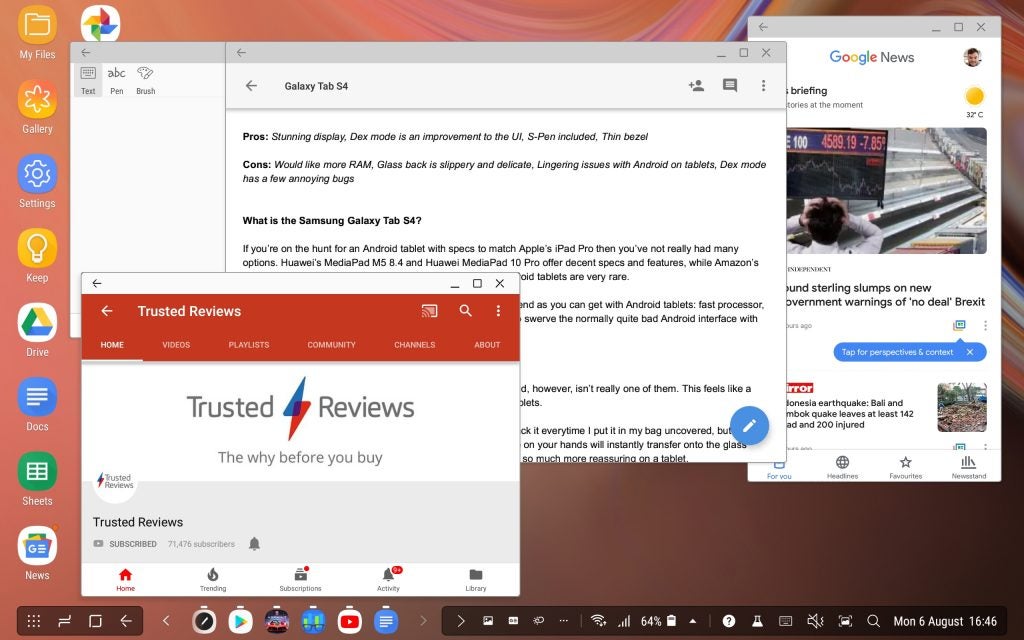
Apps can be windowed in Dex
Dex is enabled by a toggle in the quick-settings menu. Tap it and, after a couple of seconds, the Windows-esque desktop will appear. Along the bottom you’ll find the usual Android soft-keys plus a selection of running apps and a taskbar incorporating the date, time and other settings. Apps can be dragged anywhere on the desktop, but there’s no support for widgets.
When you open up an Android app in Dex, it appears as a phone-sized window. You can drag this around and open multiple windows at once, or switch to a full-screen view.
Related: Best Android Tablet
While all of Samsung’s own apps work perfectly well in either mode, I’ve come across others that struggle. Netflix, for example, refuses to fill the entire display and remains in a small window, which forces you to return to the standard Android view. I’d guess this is a problem with the app itself, rather than Dex, since other video-streaming apps – YouTube and Prime Video, for example – work fine.
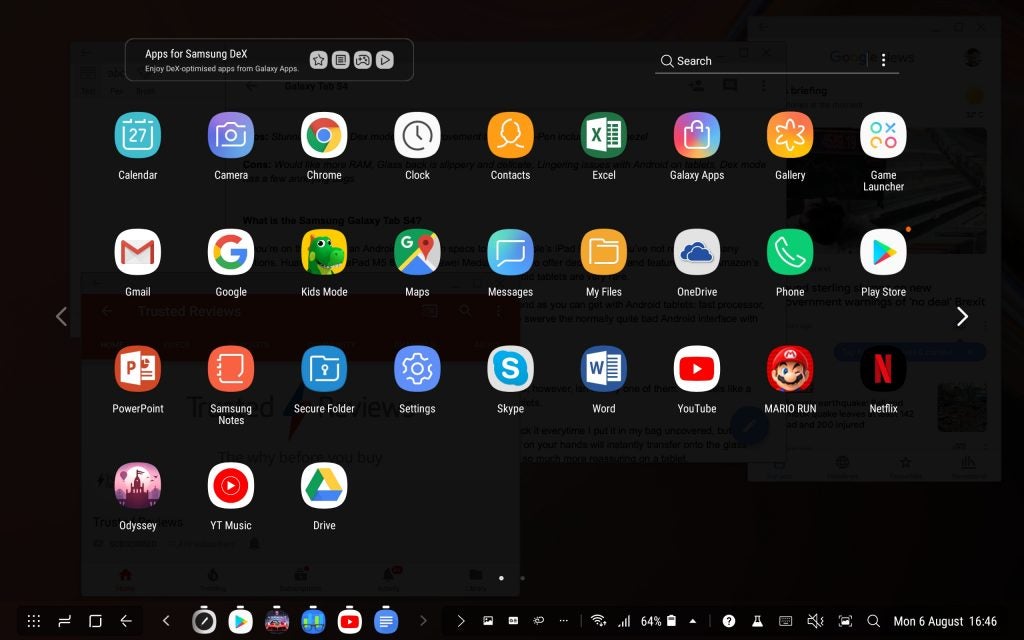
Main Dex launcher featuring apps
There are other bugs, too. I’ve found that having four or more apps on-screen at once causes slow-down, and if you add a playing video to that it can grind to halt.
There are issues with the keyboard forgetting which apps you want to input text into, and refusing to do anything. You also can’t use Screen-off Memo in Dex or any of the handy S-Pen tools that are normally available. The iris scanner, too, is less reliable in Dex.
Nevertheless, Dex is far better than the standard Android tablet view. Switching back to the regular homescreen shows how unproductive tablets are in general. Putting apps side-by-side is clunky, and having Android fill the whole display just feels a waste of space. Dex is far from perfect (yet), but it solves many of these issues.
I won’t bang on too much about app support on Android tablets, but it could be better. Even Google’s own apps, such as News, are blown-up phone versions with far too much wasted space. It’s a real shame.
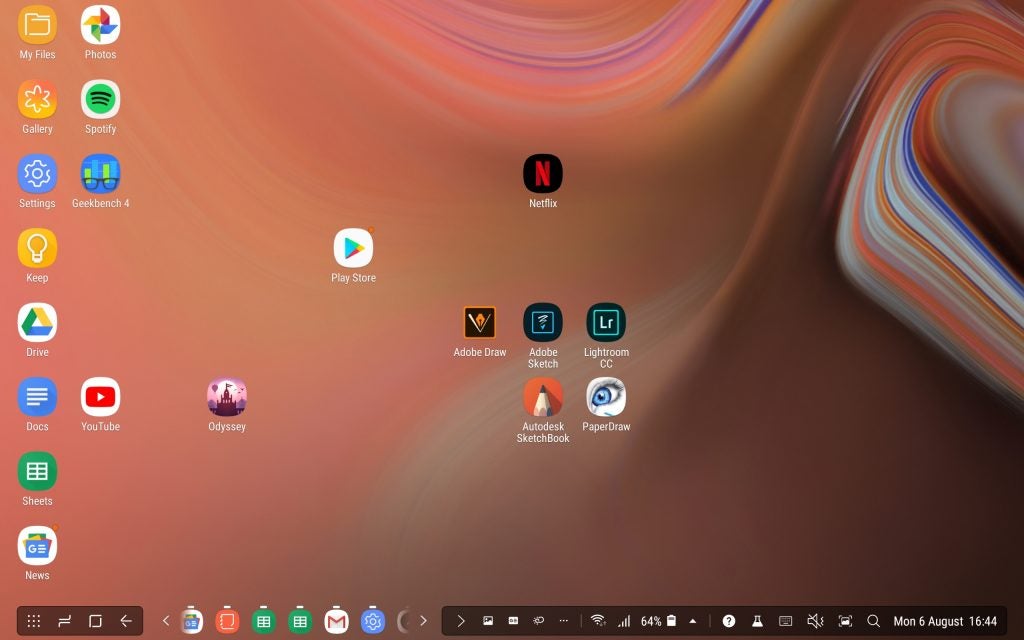
While Dex is the star of the show, there are a few other software additions here, too. Daily Board turns the Tab S4 into something akin to the Echo Show: a display that will display calendar appointments, weather and the time. This pops into life when the tablet is attached to a dock (£49.99), or when it’s charging. Bixby is here, too; we’re hoping the slightly dodgy voice assistant receives a substantial update soon.
Samsung Galaxy Tab S4 – Battery life
Inside the Galaxy Tab S4 you’ll find a 7300mAh battery, which is a decent increase over the 6000mAh cell from the Tab S3. A fast charger is included in the box, via which you’ll be able to get from 0% to 100% in a couple of hours.
In our standard array of battery tests, the Tab S4 did well. Starting from a fully charged cell, it went from 100% to 91% after an hour of HDR streaming video from Netflix. It lost a further 8% after an hour of standard HD Netflix video, and then 5% playing a video stored on the device. These results are just about on a par with those achieved by the iPad Pro 10.5 running the same tests.
Where the Tab S4, and most Android tablets, fall down is in standby time. Leaving the Tab S4 unplugged overnight saw a 9% drop. The iPad Pro dropped just 3% in the same time. This means you’ll need to keep more of an eye on the battery if you tend to leave a tablet in your bag all the time.
Why buy the Samsung Galaxy Tab S4?
The Samsung Galaxy Tab S4 is the best Android tablet you can buy. It’s pricey, but for the money you get a stunning screen, and as someone who watches a lot of videos on a tablet, I’d happily spend extra for a panel this colourful and sharp. I’m not sure this is a great buy for those wanting a tablet just for web-browsing, a bit of gaming and the odd Netflix watch on a train, however.
The S-Pen is good, Dex makes Android workable on a tablet, and battery life is on a par with the competition. I’d like more RAM and maybe a metal rear rather than glass – but those are my biggest issues.
The Tab S4’s most significant rival is the iPad Pro 10.5 (£619/$619), but you’ll have to buy the Apple Pencil (£89/$99) separately. It might also be worth waiting to see what the iPad Pro 3 has to offer.
How we test tablets
We test every tablet we review thoroughly. We use industry standard tests to compare features properly and we use the tablet as our main device over the review period. We’ll always tell you what we find and we never, ever, accept money to review a product.


